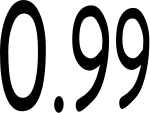 If you've ever done decimal division, you've no doubt run acros numbers that endlessly repeat, such as 0.333 0.666.
If you've ever done decimal division, you've no doubt run acros numbers that endlessly repeat, such as 0.333 0.666.
If you've ever dealt with decimal division by 7, as taught in my Mental Division With Decimal Accuracy post, you've noticed an unusual phenomenon that goes just beyond the repeating of the digits. It's that odd quality we're going to discuss in today's post.
When you divide 1 by 7, you get the number 0.142857142857... and you notice that the digits repeat endlessly. Even weirder, thought, is the fact that dividing 2 by 7 gives you the same digits in a different order: 0.2857142857142857.... and so on. In fact, as discussed in the mental division tutorial, dividing any number from 1 to 6 by 7 will always return the same digits with only the starting point changing.
Numberphile recently turned its attention to the number 142857, and explains many of the unusual qualities behind this and similar numbers:
Let's take things a step further than in the video above. If we arrange the multiples of 142857 from 1 to 6 in order, we get the following square:
1 4 2 8 5 7
2 8 5 7 1 4
4 2 8 5 7 1
5 7 1 4 2 8
7 1 4 2 8 5
8 5 7 1 4 2Now, since each row contains the same numbers, it shouldn't be surprising that each row gives the same total (27, as it happens). When you realize that 7 times 142857 is 999999, then it's not difficult to understand that 1 times 142857 plus 6 times 142857 would total 999999, as well. The same is true of 2 times 142957 plus 5 times 142857, and 3 times 142857 plus 4 times 142857. This means that all the columns will give the same total of 27 as well.This is almost like a magic square! In a true magic square, however, the diagonals would also give the same total. Sadly, in the above square, the left-to-right diagonal totals 31, and the right-to-left diagonal totals 23. This still makes it what it known as a semi-perfect magic square.
Because of the unusual nature of these cyclic numbers, all numbers will have a similar quality. Is it possible, though, that a true magic square can be formed this way?
The answer is yes, it can be done! On page 176 of W. S. Andrews' Magic Squares and Cubes, the author shares Harry A. Sayles' perfect magic square using 19ths:
01/19 = .0 5 2 6 3 1 5 7 8 9 4 7 3 6 8 4 2 1 02/19 = .1 0 5 2 6 3 1 5 7 8 9 4 7 3 6 8 4 2 03/19 = .1 5 7 8 9 4 7 3 6 8 4 2 1 0 5 2 6 3 04/19 = .2 1 0 5 2 6 3 1 5 7 8 9 4 7 3 6 8 4 05/19 = .2 6 3 1 5 7 8 9 4 7 3 6 8 4 2 1 0 5 06/19 = .3 1 5 7 8 9 4 7 3 6 8 4 2 1 0 5 2 6 07/19 = .3 6 8 4 2 1 0 5 2 6 3 1 5 7 8 9 4 7 08/19 = .4 2 1 0 5 2 6 3 1 5 7 8 9 4 7 3 6 8 09/19 = .4 7 3 6 8 4 2 1 0 5 2 6 3 1 5 7 8 9 10/19 = .5 2 6 3 1 5 7 8 9 4 7 3 6 8 4 2 1 0 11/19 = .5 7 8 9 4 7 3 6 8 4 2 1 0 5 2 6 3 1 12/19 = .6 3 1 5 7 8 9 4 7 3 6 8 4 2 1 0 5 2 13/19 = .6 8 4 2 1 0 5 2 6 3 1 5 7 8 9 4 7 3 14/19 = .7 3 6 8 4 2 1 0 5 2 6 3 1 5 7 8 9 4 15/19 = .7 8 9 4 7 3 6 8 4 2 1 0 5 2 6 3 1 5 16/19 = .8 4 2 1 0 5 2 6 3 1 5 7 8 9 4 7 3 6 17/19 = .8 9 4 7 3 6 8 4 2 1 0 5 2 6 3 1 5 7 18/19 = .9 4 7 3 6 8 4 2 1 0 5 2 6 3 1 5 7 8In this square, all of the rows, columns, and diagonals each total 81!
As an aside, numbers such as 19 have many more interesting qualities for division. To get a better idea of what I mean, check out my Leapfrog Division post.
I'll leave your mind boggled at this point, but I will suggest you do an internet search for the number 142857, as there are still more amazing qualities to discover!




No Response to "142857 And So On..."
Post a Comment